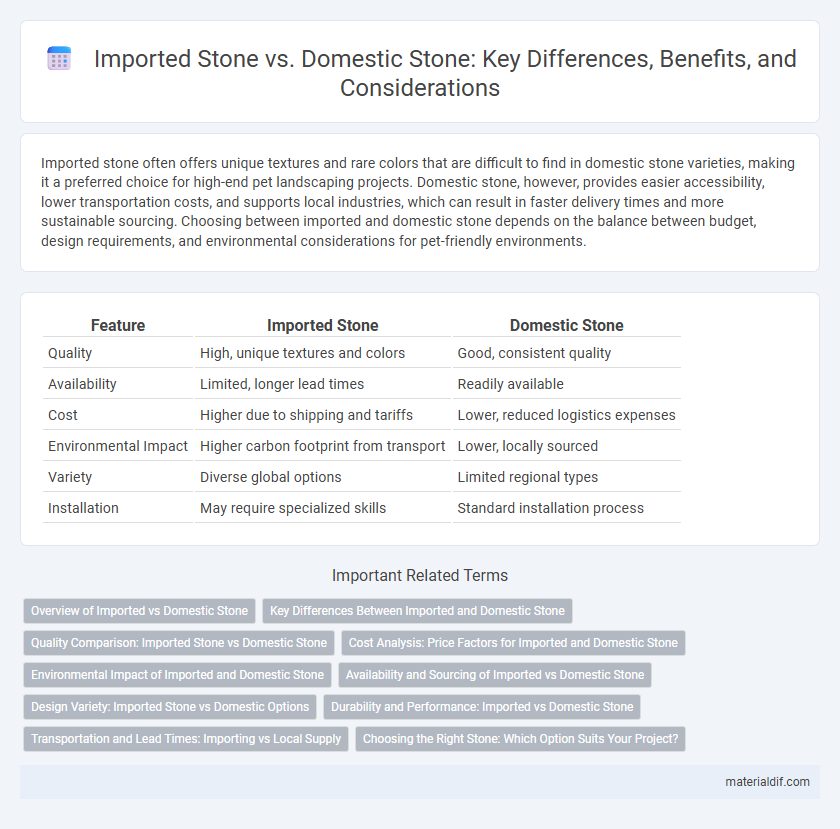Imported stone often offers unique textures and rare colors that are difficult to find in domestic stone varieties, making it a preferred choice for high-end pet landscaping projects. Domestic stone, however, provides easier accessibility, lower transportation costs, and supports local industries, which can result in faster delivery times and more sustainable sourcing. Choosing between imported and domestic stone depends on the balance between budget, design requirements, and environmental considerations for pet-friendly environments.
Table of Comparison
| Feature | Imported Stone | Domestic Stone |
|---|---|---|
| Quality | High, unique textures and colors | Good, consistent quality |
| Availability | Limited, longer lead times | Readily available |
| Cost | Higher due to shipping and tariffs | Lower, reduced logistics expenses |
| Environmental Impact | Higher carbon footprint from transport | Lower, locally sourced |
| Variety | Diverse global options | Limited regional types |
| Installation | May require specialized skills | Standard installation process |
Overview of Imported vs Domestic Stone
Imported stone offers diverse aesthetic options and unique geological characteristics not always found in domestic stone, often sourced from international quarries known for specific materials like Italian marble or Indian granite. Domestic stone provides advantages such as reduced transportation costs, lower carbon footprint, and local availability, supporting sustainability and regional economies. Choice between imported and domestic stone depends on factors like design preferences, budget, project location, and environmental considerations.
Key Differences Between Imported and Domestic Stone
Imported stone often offers a wider variety of unique colors and textures due to sourcing from diverse geological regions, while domestic stone typically provides greater availability and faster delivery times. Cost differences arise from transportation expenses and tariffs, making domestic stone generally more affordable, whereas imported stone may involve higher maintenance due to unfamiliar durability characteristics. Environmental impacts also differ; domestic stone reduces carbon footprint associated with shipping, supporting local economies and sustainable quarrying practices.
Quality Comparison: Imported Stone vs Domestic Stone
Imported stone often offers unique mineral compositions and rare aesthetic qualities that domestic stone may lack, contributing to higher perceived quality for luxury projects. Domestic stone typically provides greater consistency and easier availability, ensuring reliable quality control and faster procurement times. Evaluating both options based on durability, finish, and supplier reputation is essential for an optimal balance between cost and quality in construction or design applications.
Cost Analysis: Price Factors for Imported and Domestic Stone
Imported stone often involves higher costs due to international shipping, customs duties, and longer lead times, impacting overall pricing compared to domestic stone. Domestic stone benefits from reduced transportation expenses, lower tariffs, and quicker availability, which can lead to more competitive pricing. However, specific stone types and quality differences can influence price variations beyond geographic origin, making detailed cost analysis essential for project budgeting.
Environmental Impact of Imported and Domestic Stone
Imported stone often has a higher environmental impact due to extensive transportation emissions and longer supply chains, significantly increasing its carbon footprint. Domestic stone reduces transportation distances, lowering greenhouse gas emissions and supporting local ecosystems by minimizing habitat disruption. Sustainable quarrying practices in domestic stone sourcing further enhance environmental benefits compared to many imported alternatives.
Availability and Sourcing of Imported vs Domestic Stone
Imported stone offers a diverse range of unique textures and colors sourced from various global quarries, but it often involves longer lead times and higher shipping costs due to overseas logistics. Domestic stone provides more reliable availability with shorter delivery times and lower transportation expenses, benefiting from local quarry relationships and regional supply chains. The choice between imported and domestic stone hinges on project requirements, balancing design preferences with budget constraints and timeline considerations.
Design Variety: Imported Stone vs Domestic Options
Imported stone offers a broader design variety due to access to unique geological formations and exotic finishes unavailable domestically. Domestic stone options provide reliable availability and consistent quality but tend to have a narrower range of colors and textures. Designers seeking innovative aesthetics often prefer imported stone to achieve distinctive architectural and interior styles.
Durability and Performance: Imported vs Domestic Stone
Imported stone often features unique mineral compositions that enhance durability and resistance to weathering, making it ideal for high-traffic and exterior applications. Domestic stone, sourced locally, typically offers consistent performance with easier availability of matching materials for repairs but may vary in hardness and resistance depending on regional geology. Both types require consideration of specific project demands to optimize longevity and aesthetic value in construction and design.
Transportation and Lead Times: Importing vs Local Supply
Imported stone often involves longer transportation routes that increase lead times due to customs clearance, shipping delays, and handling at ports. Domestic stone typically offers faster delivery and reduced transportation costs because it bypasses international logistics and regulatory hurdles. Choosing local supply enhances project scheduling reliability while minimizing the environmental impact associated with long-distance freight.
Choosing the Right Stone: Which Option Suits Your Project?
Imported stone often offers unique aesthetics and rare mineral compositions that can elevate the visual appeal and value of high-end projects. Domestic stone typically provides faster availability, lower transportation costs, and supports local industries, making it ideal for budget-conscious or sustainable builds. Assess project requirements such as design goals, timeline, and budget to determine if the superior variety of imported stone or the cost-efficiency and locality of domestic stone better suits your needs.
Imported Stone vs Domestic Stone Infographic

 materialdif.com
materialdif.com